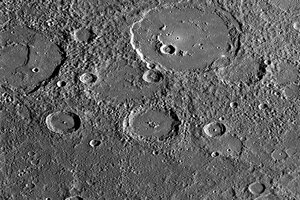MESSENGER images reveal that Mercury is shrinking
Images from NASA's Mercury-orbiting MESSENGER spacecraft suggest that the planet has contracted by as much as 8.6 miles in diameter over the past 4 billion years.

This image provided by NASA Tuesday Oct. 7, 2008 shows a close up photo of the surface of the planet Mercury taken taken on Oct. 6, 2008 when NASA's MESSENGER spacecraft flew by Mercury for the second time this year.
AP Photo/NASA
The smallest planet in our solar system is getting even smaller.
Over the past 4 billion years, Mercury has shrunk up to 8.6 miles in diameter, researchers said after analyzing images taken by NASA's MErcury Surface, Space ENvironment, GEochemistry, and Ranging (MESSENGER) spacecraft, which since 2011 has been orbiting the planet.
A detailed analysis of the study was published in a paper titled "Mercury’s global contraction much greater than earlier estimates" in the journal Nature Geoscience Sunday, March 16.
The contraction is a result of the huge difference between the temperatures of the planet's surface and its interior. The inner temperature of Mercury is hundreds of degrees higher than its surface temperature. Therefore, the heat from the interior tries to escape as it tries to achieve equilibrium with the surface temperature, causing the planet to contract, Paul K. Byrne from the Carnegie Institution in Washington DC and a lead author of the paper told the Monitor.
Located 36 million miles from the sun, Mercury consists of a "lithosphere that forms a single tectonic plate," according to the paper. This means that the planet's outer hard shell is continuous, unlike the ones we have on Earth, says Dr. Byrne.
The scientists looked at tectonic features, mainly – wrinkle ridges, that very much resemble wrinkles on someone's skin, and lobate scarps, which look like rounded cliffs, present all over the planet's surface, he says.
There are more ridges than scarps, but the scarps are hundreds of miles long and can be as high as 1.8 miles, Byrne adds.
"The features are the result of faults caused by compressional stresses that occur as a result of cooling and contraction as well as possible crystallization of the iron core in the interior of the planet," says Steven Hauk II of Case Western University and an author of the paper.
Researchers studied such deformations and conducted a statistical analysis to arrive at how much Mercury, whose current diameter is about 3,032 miles, has shrunk over the past 4 billion years.
An earlier spacecraft called Mariner 10, imaged 45 percent of the planet in three flybys between 1974 and 1975. The images obtained by Mariner suggested that there was about 1 or 2 kilometer reduction in the radius of Mercury. But the temperature history of the planet indicated that the Mercury should have cooled down and contracted much more. This is where MESSENGER has helped. The shrinking radius now fits very well with the thermal history of the planet. The planet has cooled over a period of time because the amount of radioactive material that generates heat as it decays has also decreased as the planet has aged, says Dr. Hauk.
"With MESSENGER, we have now obtained images of the entire planet at high resolution and, crucially, at different angles to the sun that show features Mariner 10 could not in the 1970s," said Hauck in a press release.
As MESSENGER completes its 2,900th orbit of Mercury later this month, researchers believe that this study will serve as a model in understanding cooling and contraction mechanisms in one-plate planets as well as in exoplanets.

